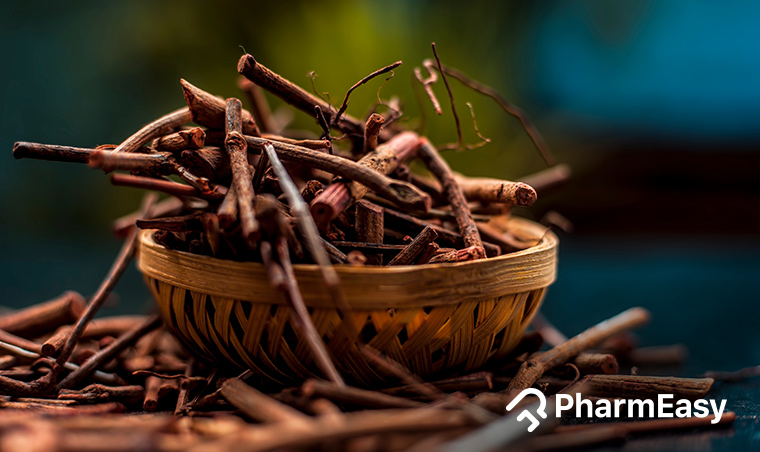Manjistha Uses, Benefits, Side Effects & More!
By Dr Ashok Pal +2 more

Get,

to manage your symptom
Get your,


4 Cr+ families
benefitted

OTP sent to 9988776655



You’ve successfully subscribed to receive
doctor-approved tips on
Whatsapp

Get ready to feel your best.

Hi There,
Download the PharmEasy App now!!


Register to Avail the Offer
Send OTPBy continuing, you agree with our Privacy Policy and Terms and Conditions

Hi There,
Sign up on PharmEasy now!!
Trusted by 4 crore+ families

OTP sent to 9988776655



You have unlocked 25% off on medicines




Code: NU25
By Dr Ashok Pal +2 more
Table of Contents
Manjistha consists of dried roots of Rubia cordifolia L. (family Rubiaceae). It is also known as Manjitha or Manjit in Hindi and Indian Madder in English. Manjistha is found throughout the country.1 The plant has a long and cylindrical root with red-colored bark. Its flowers are small, white, or greenish, whereas fruits are globose, dark purple or, black. Stems have a long, woody, and rough base.2
Rubia cordifolia has been traditionally used for its medicinal benefits. Apart from therapeutic benefits, it is also used as a natural hair dye and food colorant.2

The various chemical constituents present in Manjistha are quinones, iridoids, oleananes triterpenoids, bicyclic hexapeptides, and anthraquinones. Some notable anthraquinones are alizarin, purpurin, and rubicordifolin.2 Apart from various phytochemicals, carbohydrates and amino acids are also present in the roots of Manjistha.3
The therapeutic uses of Manjistha are as follows:
Manjistha has shown effectiveness in wound healing in experimental models.2
Also Read: Gulvel – Uses, Benefits & Side Effects
There are many ayurvedic formulations containing Manjistha available to be used in cases of skin diseases, blood purification, bacterial infections, pain, and wounds.6 Some examples are given below,
Your Ayurvedic physician will prescribe you the form and dose as per your health condition.
Also Read: Ashokarishta – Uses, Benefits, Side Effects & Precautions
There is a lack of data about the safety of oral consumption and the topical application of Manjistha. Therefore, use this herb at the discretion of the doctor.
Also Read: Suhaga – Uses, Benefits & Precautions
Manjistha consists of dried roots of Rubia cordifolia, belonging to the family Rubiaceae.1
Manjistha is called Manjit or Manjitha in Hindi.1
Manjistha is commonly used as a blood purifier. It has many other therapeutic properties like calcium channel blocking, anti-diabetic, anti-platelet, and anti-stress. It is used in the treatment of skin problems and has anticancer properties.2 The anthraquinones present in Manjistha have many biological characteristics, such as antimicrobial, hypotensive, hepatoprotective, immunomodulatory, anti-inflammatory, analgesic, antimalarial, antioxidant, antileukemic, and mutagenic.2,4
There is a lack of safety evaluations of Manjistha in human beings. Therefore, take this herb under the supervision of your doctor.
No reported data on herb-drug interaction is available.
Manjistha is beneficial in managing wounds, psoriasis, liver damage, heart disorders, cancer, diabetes, and acne.2
Yes, it is good for the heart as Manjistha root extract has cardioprotective benefits.2
Manjistha has hepatoprotective benefits. It protects the liver from potential damage.2
The antioxidant, anti-bacterial, and anti-inflammatory activities of Manjistha are beneficial for the skin. Manjistha extract inhibits acne-causing bacteria and is helpful in managing external inflammations like ulcers and skin conditions. Anthraquinones found in the extract show anti-acne activity against Malassezia furfur, Staphylococcus epidermidis, and Propionibacterium acne when compared with standard Clindamycin gel.6
Also Read: Ashwagandha – Uses, Benefits & Side Effects
1. Pharmacopoeia Commission For Indian Medicine & Homoeopathy. The Ayurvedic Pharmacopoeia Of India Part-I Volume-IX Government of India Ministry of AYUSH 2016. 2016.
2. Patil R, Mohan M, Kasture V, Kasture S. Rubia cordifolia: a review. Oriental Pharmacy and Experimental Medicine [Internet]. 2009 Mar 31 [cited 2022 Feb 9];9(1):1–13. Available from: https://www.researchgate.net/publication/244943682_Rubia_cordifolia_a_review
3. (PDF) Therapeutic Importance of Rubia cordifolia Linn. and its Phytochemical Analysis [Internet]. [cited 2022 Feb 16]. Available from: https://www.researchgate.net/publication/343826995_Therapeutic_Importance_of_Rubia_cordifolia_Linn_and_its_Phytochemical_Analysis
4. Meena AK. A review on Rubia cordifolia Its phyto constituents and therapeutic uses [Internet]. Vol. 2. 2010. Available from: https://www.researchgate.net/publication/331398141
5. Chandrashekar B, Prabhakara S, Mohan T, Shabeer D, Bhandare B, Nalini M, et al. Characterization of Rubia cordifolia L. root extract and its evaluation of cardioprotective effect in Wistar rat model. Indian Journal of Pharmacology [Internet]. 2018 Jan 1 [cited 2022 Feb 10];50(1):12. Available from: /pmc/articles/PMC5954628/
6. (PDF) Manjistha(Rubia Cordifolia)- A helping herb in cure of acne [Internet]. [cited 2022 Feb 9]. Available from: https://www.researchgate.net/publication/302902410_ManjisthaRubia_Cordifolia-_A_helping_herb_in_cure_of_acne
Disclaimer: The information provided here is for educational/awareness purposes only and is not intended to be a substitute for medical treatment by a healthcare professional and should not be relied upon to diagnose or treat any medical condition. The reader should consult a registered medical practitioner to determine the appropriateness of the information and before consuming any medication. PharmEasy does not provide any guarantee or warranty (express or implied) regarding the accuracy, adequacy, completeness, legality, reliability or usefulness of the information; and disclaims any liability arising thereof.
Links and product recommendations in the information provided here are advertisements of third-party products available on the website. PharmEasy does not make any representation on the accuracy or suitability of such products/services. Advertisements do not influence the editorial decisions or content. The information in this blog is subject to change without notice. The authors and administrators reserve the right to modify, add, or remove content without notification. It is your responsibility to review this disclaimer regularly for any changes.

Leave your comment...
Comments